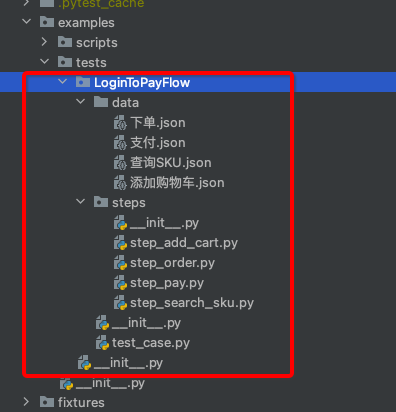当Pytest遇上MVC分层设计自动化用例就该这么写¶

引子¶
数据写在代码里,追求快速编写用例,是我设计tep的一个特点,这在个人编写时是一种非常良好的体验。但相比于HttpRunner、JMeter等来说,总觉得还差点意思。思考良久,总结为三个字:工程化。工程化是我近一年在学习Java并参与了2个测试平台模块开发,和写了几个小工具后,感受到的一种编程思想。而其中最明显的就是Spring的MVC分层设计。为了让tep更工程化,后续版本将以MVC模块编写用例为准,同时会兼容之前的脚本式快速编写。
示例¶
测试用例¶
test_case.py是测试用例,包含的只有测试步骤:
import allure
from examples.tests.LoginToPayFlow.steps.step_add_cart import step_add_cart
from examples.tests.LoginToPayFlow.steps.step_order import step_order
from examples.tests.LoginToPayFlow.steps.step_pay import step_pay
from examples.tests.LoginToPayFlow.steps.step_search_sku import step_search_sku
from utils.cache import TepCache
from utils.step import Step
"""
测试登录到下单流程,需要先运行utils/fastapi_mock.py
"""
@allure.title("从登录到下单支付")
def test(login, env_vars, case_vars):
case_vars.put("token", login["token"])
cache = TepCache(env_vars=env_vars, case_vars=case_vars)
Step("搜索商品", step_search_sku, cache)
Step("添加购物车", step_add_cart, cache)
Step("下单", step_order, cache)
Step("支付", step_pay, cache)
TepCache是“缓存”,包括global_vars、env_vars、case_vars三个级别的变量池。
Step是一个泛化调用类,作用是打日志,调用第二个参数对应的步骤函数。
测试步骤¶
from utils.cache import TepCache
from utils.func import data
from utils.http_client import request
def step_search_sku(cache: TepCache):
url = cache.env_vars["domain"] + "/searchSku"
headers = {"token": cache.case_vars.get("token")}
body = data("查询SKU.json")
response = request("get", url=url, headers=headers, params=body)
assert response.status_code < 400
cache.case_vars.put("skuId", response.jsonpath("$.skuId"))
cache.case_vars.put("skuPrice", response.jsonpath("$.price"))
from utils.cache import TepCache
from utils.func import data
from utils.http_client import request
def step_add_cart(cache: TepCache):
url = cache.env_vars["domain"] + "/addCart"
headers = {"token": cache.case_vars.get("token")}
body = data("添加购物车.json")
body["skuId"] = cache.case_vars.get("skuId")
response = request("post", url=url, headers=headers, json=body)
assert response.status_code < 400
cache.case_vars.put("skuNum", response.jsonpath("$.skuNum"))
cache.case_vars.put("totalPrice", response.jsonpath("$.totalPrice"))
步骤函数以step开头,尤其注意的是cache借助Python
Typing提示,可以在编写下面代码时,获得PyCharm语法提示,所以一定不要忘了加上: TepCache:

步骤函数里面由基本信息(url、headers、body),数据初始化,请求,断言,数据提取几个部分组织,从上往下顺序编写。
测试数据¶
数据代码分离,在MVC分层设计中这点就特别重要,在data目录下存放的不做任何参数化的纯粹json:
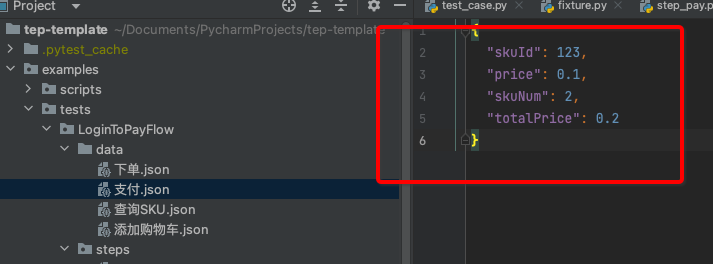
参数化都放在步骤函数里面来写。数据代码分离的好处是,比如现在写的用例是买3件商品,假如你想改成买10件,只改json的数据就可以了,不需要改动任何代码。你可能会想,把这个数字放在代码里,不也是只改个值吗?确实如此,但这不符合MVC分层设计了。
以SpringMVC作为参照:
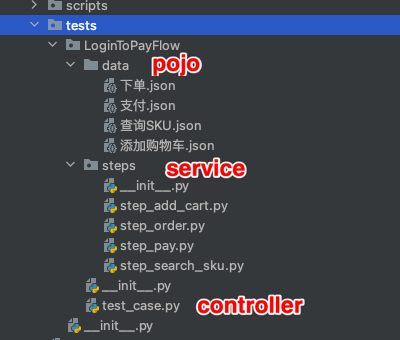
testcase.py相当于controller,steps相当于service,data相当于pojo,各层只做自己的事,多写点代码,换来的是可读性强、维护性高、层次分明的“工程化资产”。
日志输出¶
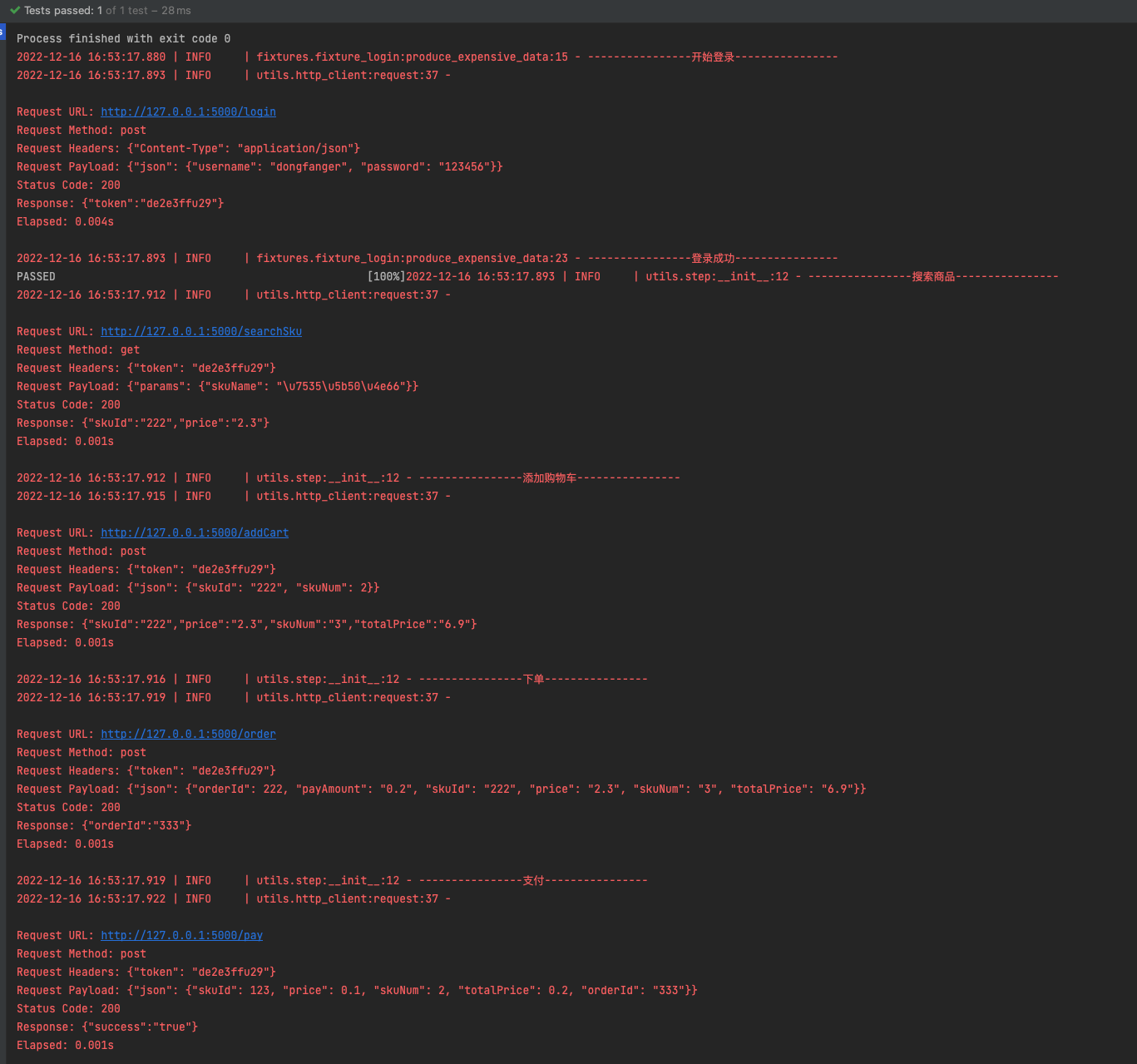
原理¶
Step泛化调用:
from loguru import logger
from utils.cache import TepCache
class Step:
"""
测试步骤,泛化调用
"""
def __init__(self, name: str, action, cache: TepCache):
logger.info("----------------" + name + "----------------")
action(cache)
TepCache缓存:
class TepCache:
"""
提供缓存服务,包括全局变量、环境变量、用例变量
"""
def __init__(self, global_vars=None, env_vars=None, case_vars=None):
self.global_vars = global_vars
self.env_vars = env_vars
self.case_vars = case_vars
fixture实现的变量池:
@pytest.fixture(scope="session")
def global_vars():
"""
全局变量,读取resources/global_vars.yaml,返回字典
"""
with open(os.path.join(Config.project_root_dir, "resources", "global_vars.yaml")) as f:
return yaml.load(f.read(), Loader=yaml.FullLoader)
@pytest.fixture(scope="session")
def env_vars():
"""
环境变量,读取resources/env_vars下的变量模板,返回字典
"""
env_active = tep_config()['env']["active"]
env_filename = f"env_vars_{env_active}.yaml"
with open(os.path.join(Config.project_root_dir, "resources", "env_vars", env_filename)) as f:
return yaml.load(f.read(), Loader=yaml.FullLoader)
@pytest.fixture(scope="session")
def case_vars():
"""
测试用例的动态变量,1条测试用例1个实例,彼此隔离
"""
class CaseVars:
def __init__(self):
self.dict_in_memory = {}
def put(self, key, value):
self.dict_in_memory[key] = value
def get(self, key):
value = ""
try:
value = self.dict_in_memory[key]
except KeyError:
logger.error(f"获取用例变量的key不存在,返回空串: {key}")
return value
return CaseVars()
登录fixture:
import pytest
from loguru import logger
from utils.http_client import request
@pytest.fixture(scope="session")
def login(tep_context_manager, env_vars):
"""
tep_context_manager是为了兼容pytest-xdist分布式执行的上下文管理器
该login只会在整个运行期间执行一次
"""
def produce_expensive_data(variable):
logger.info("----------------开始登录----------------")
response = request(
"post",
url=variable["domain"] + "/login",
headers={"Content-Type": "application/json"},
json={"username": "dongfanger", "password": "123456"}
)
assert response.status_code < 400
logger.info("----------------登录成功----------------")
return response.json()
return tep_context_manager(produce_expensive_data, env_vars)
TepResponse支持response.jsonpath写法:
def request(method, url, **kwargs):
template = """\n
Request URL: {}
Request Method: {}
Request Headers: {}
Request Payload: {}
Status Code: {}
Response: {}
Elapsed: {}
"""
start = time.process_time()
response = requests.request(method, url, **kwargs) # requests.request原生用法
end = time.process_time()
elapsed = str(decimal.Decimal("%.3f" % float(end - start))) + "s"
headers = kwargs.get("headers", {})
kwargs.pop("headers")
payload = kwargs
log = template.format(url, method, json.dumps(headers), json.dumps(payload), response.status_code, response.text,
elapsed)
logger.info(log)
allure.attach(log, f'request & response', allure.attachment_type.TEXT)
return TepResponse(response)
class TepResponse(Response):
"""
二次封装requests.Response,添加额外方法
"""
def __init__(self, response):
super().__init__()
for k, v in response.__dict__.items():
self.__dict__[k] = v
def jsonpath(self, expr):
"""
此处强制取第一个值,便于简单取值
如果复杂取值,建议直接jsonpath原生用法
"""
return jsonpath.jsonpath(self.json(), expr)[0]
读取数据文件:
def data(relative_path: str) -> dict:
"""
与steps同层级的data目录+传入的相对路径
"""
caller = inspect.stack()[1]
steps_path = os.path.dirname(caller.filename)
data_path = os.path.join(os.path.dirname(steps_path), "data", relative_path)
if os.path.exists(data_path):
with open(data_path, encoding="utf8") as f:
return json.load(f)
logger.error("数据文件不存在")
return {}
体验¶
本次设计的编写方法,跟我公司的测试平台的体验很类似,因为习惯了平台操作,用这种方式写代码竟然出奇的习惯,基本上没有卡点或特别绕的感觉,在PyCharm中也能体验到测试平台的顺畅感。大家也可以试一下。
第一步,添加用例:
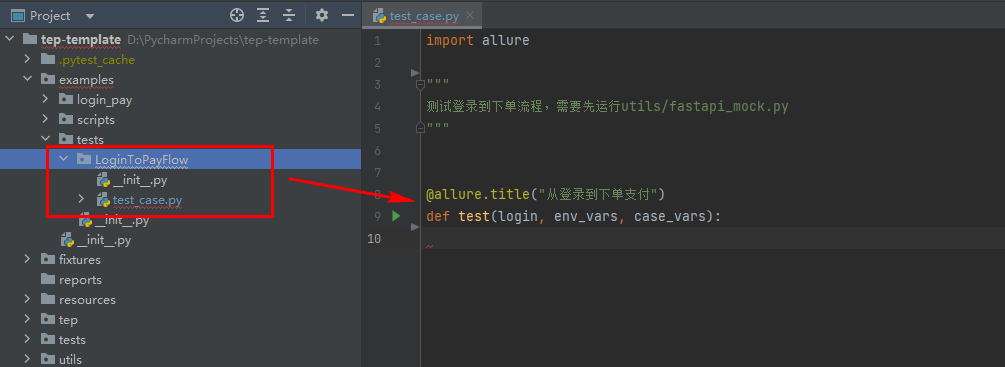
第二步,添加步骤:

Step这一行,从左到右顺序录入,步骤名称,步骤函数,cache,特别顺手。
第三步,添加步骤函数,直接复制这里的函数名,到steps包下面新建文件:
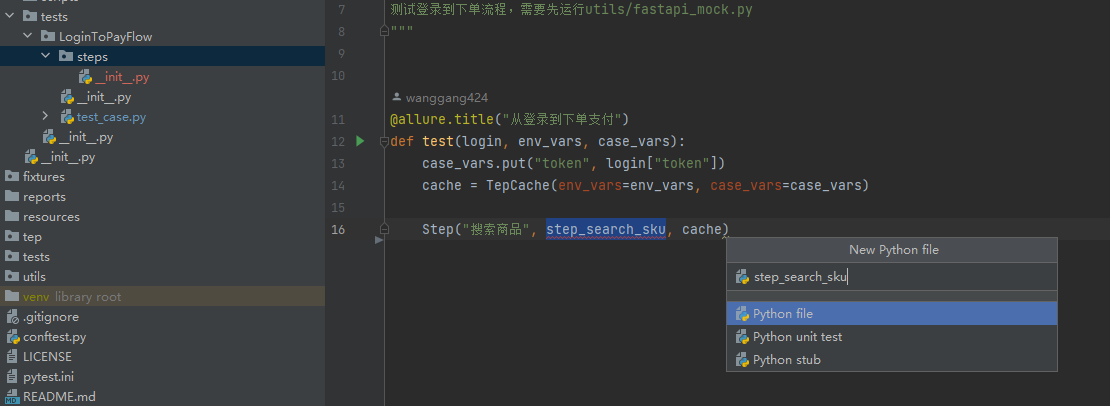
然后输入函数定义:
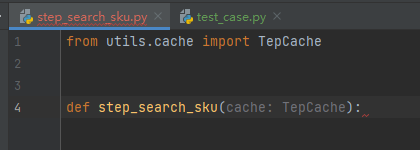
这里一定要记得输入TepCache的Typing提示,以获得PyCharm语法提示:
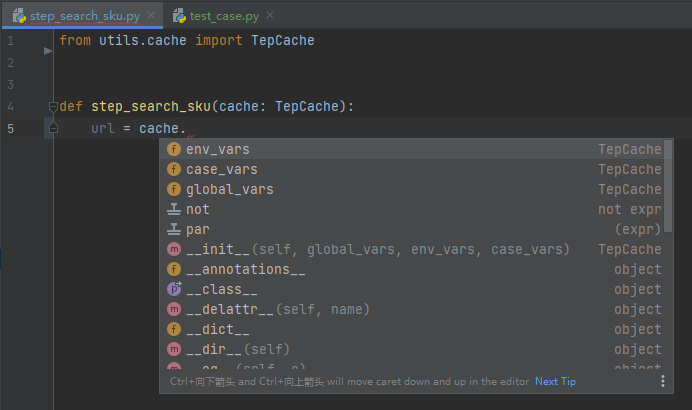
接着顺序输入url、headers、body:
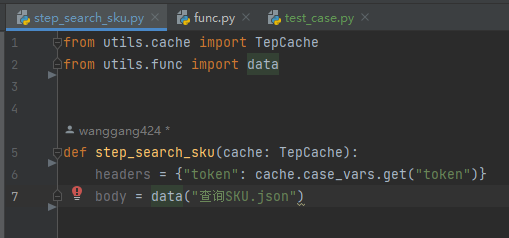
第四步,在data目录下新建数据文件:
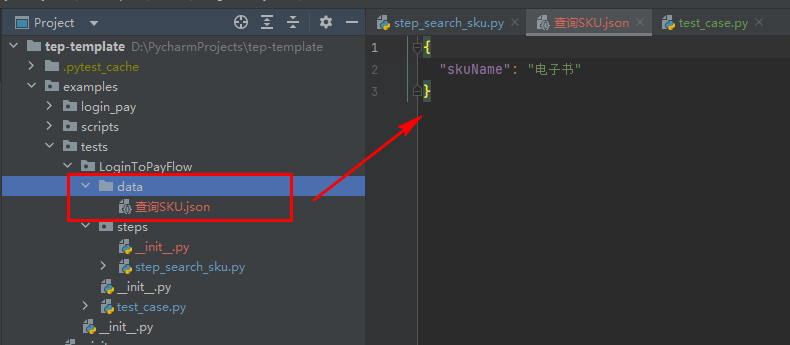
第五步,回到步骤函数,做参数化、请求、断言、数据提取等:
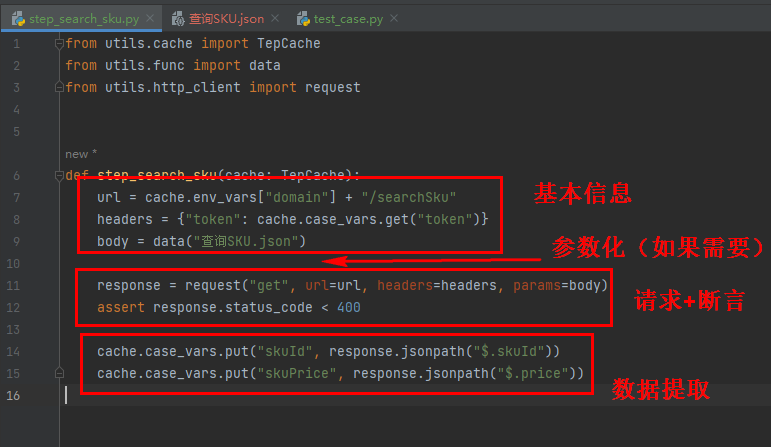
第六步,再回到测试用例,导入步骤函数:
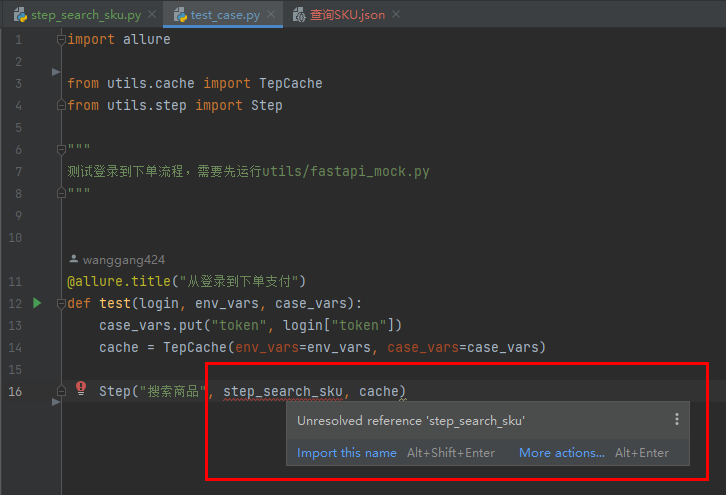
其他步骤以此类推。tep后续将以MVC分层设计编写方式为主,老用例仍然会兼容,可以不修改,新用例可以在tep正式发布后,尝试下。
tep-template加了几个新库可能需要安装下:
pip install jsonpath
pip install filelock
pip install pytest-xdist
目前代码已经上传到预览版,欢迎加我或进群交流。
参考资料:
